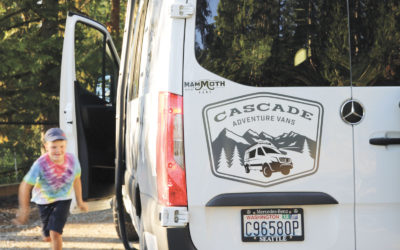Since Time Immemorial is a recurring series featuring community members whose families have been here since time immemorial. The ancestral knowledge carried by Lhaq’temish, Nooksack, and other Coast Salish peoples is knowledge about how to live in our shared home in a good, life-sustaining way. We live in a time when we need to restore our relationship with Mother Earth and with one another. We are grateful for these stories, told in the words of each featured individual.

Photograph by Julie Trimingham
Joshua Olsen is an enrolled member of the Nooksack Tribe. A former Community Food Co-op cashier and baker, and Whatcom County Library System tribal liaison, he now works for Nooksack’s Cultural Natural Resources Department and continues to practice commercial and subsistence fishing. As a student of the Nooksack language, Lhechelesem, Joshua contributed to the Sacred Land Conservancy’s piece on Indigenous place names for the Mountaineers magazine: “The Many Faces of a Mountain.”
We’re here at Nugent’s Corner, by the Nooksack River. Traditional Nooksack land. Is this where you grew up?
I grew up in the Deming and Acme area, various places along the river. I actually camp down at the river here quite a few nights out of the year mostly, you know, for fishing purposes. It’s a way of life. Fishing, either commercial or subsistence, has always really sustained me, my family, and previous generations of my family.
Who taught you how to fish?
My dad. He taught me different ways on how to do it. A lot of times we were just scraping by without any kind of boat, and we’d have only one raggy set net, and we’d go find some place to throw it into the river. After, we’d pack out probably eight or 10 large fish by hand at night. They’d either be tied together through their gills or in a bag—I’ll always remember being a little kid and packing more fish than I can reasonably carry up a hill.
What’s a set net?
You have a heavy rope made with lead—the lead line—and that holds the bottom of the net taut from the top of the net, which is attached to a rope with corks or floats on it. The net goes out into the river, and you’ve got part of the net on the bank.
You throw one end into the middle of the river?
You look for places in the water where it is flowing upstream, and that’s pretty much where the fish like to hang out. That’s where they relax, because they can just kind of float around in the same spot. And generally, the rapids will push them into that backwards-moving water.
And is set net a pretty traditional way to fish on the water?
It’s a post-colonial way to fish on the river. Pre-colonial times, our people would use dip nets and gaff hooks, spears. They would also construct weirs all the way across the river, and then the fish would be funneled into a trap or chute where they could be sorted into which ones to let go and which ones to keep.
I know you’re a student of language as well as of history.
I started studying the language back in 2010, and just a few years ago I began talking and meeting with George Adams. More recently, I’ve been doing the master apprenticeship with him. I’ve also been meeting with him and people from the University of British Columbia. There’s some people who are associated with UBC who are intent on finishing the dictionary and grammar book that was started by, I believe, Brent Galloway, who passed away before he could finish it. So these linguists have taken up that work and I’ve been able to meet with them and give them my opinion, as someone who’s not a trained linguist, about the work and how the book is structured.
As you’re learning the language, do you find that it changes your perspective or opens up the world in any kind of way?
It’s a verb-based way of speaking, rather than noun-based like English. The words are based on actions and doing. It kind of reinforces that saying: thoughts become words and words become actions. I think it encourages a more pragmatic view of things: what things do, rather than what they are.
What do you like to do for fun?
I just like to hang out with people, visit with friends and family, play with remote-control boats. I do a lot of crafting. I practice archery and work on an old truck that I’m restoring piece by piece. I watch anime (a lot of anime). Yeah, just lots of different things. I used to garden a lot. My favorite thing is sharing new experiences with my son, he’s 11, it’s an opportunity to connect with and heal my own inner child in being there for him. I’m just pretty grateful and proud to be born into the life that I was born into. It was tough—it’s still tough—but I’m still grateful for it.
How do I say “thank you” in Nooksack?
Nooksack has historically used 3 different languages: Lushootseed from the south, Halkomelem from the north, and Lhechelesem from Nooksack and Lake Whatcom. In Lhechelesem, I say Yólh kw’omalh ashoy…
Yölh kw’omalh ashow, Joshua!
Julie Trimingham is a mother, writer, and non-tribal member of the Sacred Lands Conservancy (SacredSea.org), a Lhaq’temish-led non-profit dedicated to protecting Native sovereignty, treaty rights, sacred sites, and the life and waters of Xw’ullemy (the Salish Sea bioregion). Her heart is filled by the work to protect and promote ancestral place-based knowledge so that we can all learn to live here, with one another, and with Mother Earth, in a good way.





